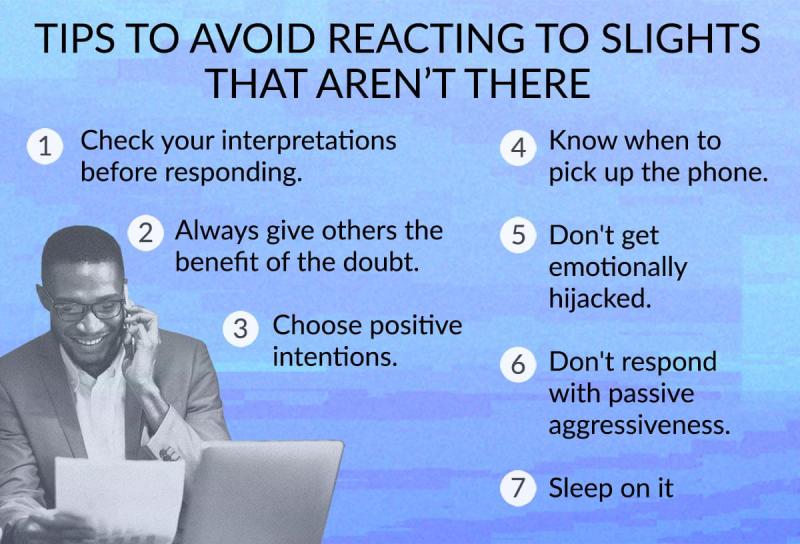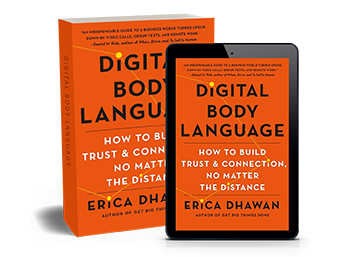
“Digital tools that got little traction for years are now business requirements, not only for productivity, but also for client engagement, business development, even social connection and celebration. The question we have to ask ourselves is no longer how will we adapt to our new normal, but more importantly, how will we create a better normal?”
Erica Dhawan, AESC Virtual Conference. May 12, 2021
Erica Dhawan is an award-winning speaker, author and student of innovation and collaboration who spoke about digital body language, why it matters and how to use it to master sales and engagement at the 2021 AESC Virtual Conference, “Thriving in the Next Normal.”
A New Language Barrier
In a recent study of over 3000 office workers Dhawan found that the average employee is wasting up to four hours per week on poor, unclear or confusing digital communication. If roughly three-fourths of face-to-face communication is nonverbal body language, what are we missing when we are no longer communicating face to face? When we are engaging with people on screen, Dhawan said, “We can't just sense if someone's on the verge of tears or really excited; we can't read the ‘lean in,’ in a sales conversation with a client, the way we used to.” Communicating digitally – through email, via text, on screen or by using digital collaboration tools requires that leaders and colleagues reimagine collaboration, trust and engagement.
A New Skill Set
In order to communicate effectively and build a level of connection and trust no matter the distance, Dhawan argued that we need to build a critical skill called digital body language. “Digital body language is the cues and signals we send in our digital communication that make up the subtext of our messages.”
In her keynote, Dhawan presented five key principles of digital body language to mitigate the weaknesses and leverage the benefits of the way we communicate in the digital age.
1. BREVITY CREATES CONFUSION
The pressure to communicate quickly can often cause us to take shortcuts, skip critical details, and sometimes leave out context altogether.
Dhawan illustrated the point with an anecdote about a leader who sent a no-subject calendar invitation to a colleague who had recently heard about budget cuts. Because there was no subject line in the meeting request, the colleague thought he was about to get fired when the leader only wanted to talk about a client project. The lesson: never confuse a brief message with a clear message.
In another illustration, a chief marketing officer was working with one of her service providers reviewing a deck they prepared for her, and she said ‘let's iterate on this topic a bit more.’ That team went back and spent about 10 hours creating five new slides. When she got back to them and said, ‘I actually just wanted two more bullet points,’ imagine how de-motivated the team felt. Dhawan explained, “We have to understand that brevity creates confusion, that we must choose to be clear, not brief, even when we feel rushed to be fast in a digital world.”
"Communicating digitally – through email, via text, on screen or by using digital collaboration tools requires that leaders and colleagues reimagine collaboration, trust and engagement. "
2. COMMUNICATE YOUR MIND.
In all of our messages we have to make certain we are clear about our intentions and our expectations: what is the ask? What is the priority level? Why do you and others need this information? Dhawan described some of her clients’ highly efficient email acronyms. WINFY means ‘what I need from you,’ and senders are required to answer that question at the top of the message. Other acronyms indicate required response times. For example, 2H means ‘I need this in two hours.’ 4D means ‘I need this in four days.’ NNTR means ‘no need to respond.’
“We have to bring nuance back because body language is transformed, online,” Dhawan said.
Consider this: Does a word in upper case connote excitement? Urgency? Anger? Is a period at the end of a text message passive-aggressive, or just good grammar? Are multiple question marks friendly, or accusatory? “This is the brave new world we're in,” Dhawan said.
3. HOLD YOUR HORSES.
The pressure to communicate fast often rewards the first people to respond to an email or the quickest person to jump in on a zoom call, instead of what might be the most thoughtful idea. Dhawan explained, “When we just reward the first person who responds or the three people who agree, we may miss out on the fourth person who disagrees. When certain people over-talk in video calls, we may not hear from someone who has a different perspective.” Hold your horses means being intentional about showing good digital body language.
Being intentional can be as simple as sending an agenda or questions in advance, to give introverts time to process ideas before a meeting. Calling on people according to a set order ensures everyone has an opportunity to speak, not just the most vocal or confident team members. Dhawan advised, “Holding our horses will allow us to choose thoughtfulness over hastiness.”
4. ASSUME THE BEST INTENT.
So much is lost in digital communication, it is easy to misread, misunderstand, jump to conclusions, and assume the worst. Dhawan cautioned, “We are tone deaf. We need to become tone deft in a digital world.” Dhawan’s tips to avoid imagining and reacting to slights that aren’t there include:

- Check your interpretations before responding.
- Always give others the benefit of the doubt.
- Choose positive intentions.
- Know when to pick up the phone.
- Don't get emotionally hijacked.
- Don't respond with passive aggressiveness.
- Sleep on it
“These simple things can go a long way in creating that culture of empathy, respect, connection, and frankly sales in our modern world.” Dhawan said.
5. FIND YOUR VOICE.
Finding your voice means knowing whether you, your leaders, your team members, and your clients are introverts or extroverts, digital natives or digital adapters. It means understanding different cultural norms. This understanding can improve how you work with others, and help you resist the impact of any implicit bias. For example:
- Introverts prefer time to think. Send agendas and questions in advance. Don't interrupt their speaking. Consider a set speaking order. Create downtime between meetings.
- Extroverts like their airtime so know how to give it to them, but manage it: have breakout rooms, use working sessions, use virtual whiteboards. If extroverts can write their ideas before they speak, it helps them become more concise.
- Digital natives thrive in text shorthand. They hate voicemail, but they may send a voice note. They don't like phone calls out of the blue.
- Digital adapters prefer phone and in person communication. They may be more reluctant with new tech. They prefer higher quality, less frequent messages.
- In traditionally Eastern cultures much more formal digital body language is the norm, including more context, greeting people and exchanging niceties before asking for something.
- In more traditionally Western cultures people are much more direct and to the point.
Cultivating the essential skill of digital body language requires learning to use what is authentic to ourselves, but also understanding how to connect with the digital body language of others. How to determine the preferred language of others? “Sometimes that requires simply asking them,” Dhawan said.
“We have different preferences and setting some clear hybrid collaboration norms is incredibly important right now.”
Tips for refining your digital body language:
- Know when to pick up the phone. Dhawan said, “I'm such a fan of the lost art of the phone call and how it can solve problems that are wasting us so much time in texts, email, chat tools, slack tools, you name it.”
- Make your meetings accessible through closed captioning to alleviate hearing and language barriers, or record meetings so people can listen again or read a transcript.
- Send quick recap emails summarizing the key points and insights and confirming next steps within 30 minutes of a meeting. For Dhawan, “It’s like the new, virtual handshake.”
- Activate what's been best about our digital world to make meetings even better, for example by having an existing client briefly join a sales pitch to a prospective client or showing short videos to enhance an on-screen meeting.
- And when you are in that face-to-face meeting? Put your phone on do not disturb, so you’re not looking down at your screen when someone is trying to make eye contact with you.
A New Tool
The way we communicate has been transformed into a lexicon we are only beginning to understand. In her recently published book Digital Body Language Dhawan offers a lively and accessible guide to navigating the new reality of communication and developing the critical skills for building trust and connection in the digital world.
Digital Body Language is available at www.dblbook.com and booksellers worldwide.
Get AESC SmartBrief for the latest in C-level news.

